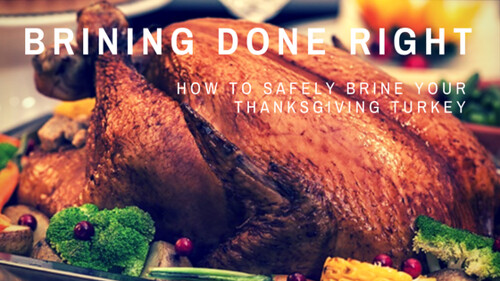
Are you interested in brining a turkey, but aren’t quite sure how to do it safely? USDA is at your service! Though brining may sound like something only done commercially or by a certified chef, it’s quite simple with the right strategy — that means following safe food preparation steps.
Brining simply means to soak your turkey in a water and salt solution (the brine). Often, other ingredients are added to the brine, such as sugar, molasses, honey or corn syrup. The purpose of a brine is to produce a more tender and flavorful turkey.
According to research published in the Journal of Food Science, the salt in the brine dissolves a bit of the protein in the muscle fibers, and allows the meat to absorb the brine and retain moisture during cooking. This makes the poultry juicier, more tender and improves the flavor. There is no shortage of brine recipes, but in order to reap the benefits of brining, you must use the following safe steps.
Brining Steps:
Fresh turkeys can only be kept safely for one to two days, in the refrigerator. Let’s use a fresh whole turkey in our example and follow the four steps to safe food preparation:
CLEAN
- Begin by washing hands with warm water and soap for a minimum of 20 seconds.
- Also wash and sanitize surfaces such as countertops and sink using a solution of 1 tablespoon of unscented, liquid chlorine bleach in 1 gallon of water. Let the solution stand on the surfaces for a few minutes; then air dry or pat dry with clean paper towels.
SEPARATE
- Do NOT wash the bird prior to brining. Washing raw poultry can cause cross-contamination — raw juices that can contain harmful bacteria spilling onto other foods or splashing on countertops.
- Prepare the brine by mixing ingredients until all of the salt is dissolved. If your brine recipe calls for heating the mixture, be sure to cool it to room temperature before using it. Then place the turkey in the brine and place in the refrigerator. Don’t leave the turkey sitting out at room temperature while brining.
- Place the bird breast down in a large container made of food-grade plastic, stainless steel or glass, or a brining bag. Be sure the container will fit in your fridge.
- Add brine, covering the entire turkey. Carefully secure the container with a lid or cover, so as not to splash other foods or surfaces inside your refrigerator.
- Place the container in the refrigerator for the period of time specified in the recipe. The amount of time will depend on the type of brine you use; however, do not brine any longer than two days and always keep the turkey and brine refrigerated (at 40°F or less).
- Remove turkey from brine after the recommended time.
NOTE: If you must rinse the turkey and clean out the cavity, first take the time to remove dishes, dish drainers, dish towels, sponges and other objects from around the sink area. Then cover the area around your sink with paper towels. Place the roasting pan next to the sink, ready to receive the turkey.
Clean the sink with hot soapy water, rinse well and fill it with a few inches of cold water. Even if the cavity is partially frozen, use cold water to rinse the cavity. Cold water is still warmer than the frozen cavity. Run the water gently to prevent splashing. Make sure the water is coming out the other end of the cavity. If it isn’t, the neck or giblets may still be in there.
And that’s it! No need to scrub or rinse the rest of the turkey. Hold the turkey up to let it drain into the sink and gently place the turkey in the roasting pan. Remove the paper towels, clean the sink and the area around the sink with hot soapy water, and proceed with your preparations. See To Wash or Not Wash.
COOK
- Cook the brined turkey according to USDA’s food safety recommendations. You can view more tips on preparation of a turkey at: Let’s Talk Turkey
- Check the internal temperature of the turkey in the innermost part of the thigh and wing and the thickest part of the breast with a food thermometer. The minimum internal temperature should reach 165°F for safety.
- For quality, let the turkey stand for 20 minutes before carving to allow juices to set.
CHILL
- Divide leftovers into smaller portions. Refrigerate or freeze in covered shallow containers for quicker cooling.
- Cooked turkey, stuffing and gravy should not be left out at room temperature longer than 2 hours; 1 hour in temperatures above 90°F.
- Use refrigerated turkey, stuffing and gravy within 3 to 4 days.
Brining can be used with a variety of poultry and meats. See more food safety tips on brining, including suggested recipes in the Brining, Basting and Marinating fact sheet.
If you have questions about your Thanksgiving dinner, call the USDA Meat and Poultry Hotline at 1-888-MPHotline (1-888-674-6854) to talk to a food safety expert. You can also chat live at AskKaren.gov, available from 10 a.m. to 6 p.m. ET, Monday through Friday, in English and Spanish. If you need help on Thanksgiving Day, the Meat and Poultry Hotline is available from 8 a.m. to 2 p.m. ET.
